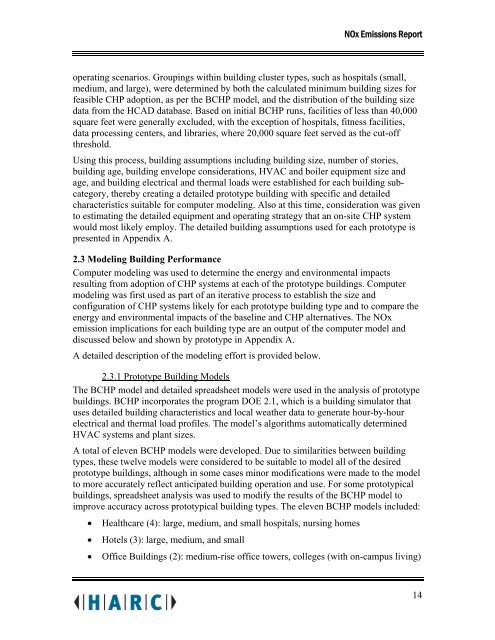NOx Emissions Impacts from Widespread Deployment of CHP in ...
NOx Emissions Impacts from Widespread Deployment of CHP in ...
NOx Emissions Impacts from Widespread Deployment of CHP in ...
Create successful ePaper yourself
Turn your PDF publications into a flip-book with our unique Google optimized e-Paper software.
<strong>NOx</strong> <strong>Emissions</strong> Report<br />
operat<strong>in</strong>g scenarios. Group<strong>in</strong>gs with<strong>in</strong> build<strong>in</strong>g cluster types, such as hospitals (small,<br />
medium, and large), were determ<strong>in</strong>ed by both the calculated m<strong>in</strong>imum build<strong>in</strong>g sizes for<br />
feasible <strong>CHP</strong> adoption, as per the B<strong>CHP</strong> model, and the distribution <strong>of</strong> the build<strong>in</strong>g size<br />
data <strong>from</strong> the HCAD database. Based on <strong>in</strong>itial B<strong>CHP</strong> runs, facilities <strong>of</strong> less than 40,000<br />
square feet were generally excluded, with the exception <strong>of</strong> hospitals, fitness facilities,<br />
data process<strong>in</strong>g centers, and libraries, where 20,000 square feet served as the cut-<strong>of</strong>f<br />
threshold.<br />
Us<strong>in</strong>g this process, build<strong>in</strong>g assumptions <strong>in</strong>clud<strong>in</strong>g build<strong>in</strong>g size, number <strong>of</strong> stories,<br />
build<strong>in</strong>g age, build<strong>in</strong>g envelope considerations, HVAC and boiler equipment size and<br />
age, and build<strong>in</strong>g electrical and thermal loads were established for each build<strong>in</strong>g subcategory,<br />
thereby creat<strong>in</strong>g a detailed prototype build<strong>in</strong>g with specific and detailed<br />
characteristics suitable for computer model<strong>in</strong>g. Also at this time, consideration was given<br />
to estimat<strong>in</strong>g the detailed equipment and operat<strong>in</strong>g strategy that an on-site <strong>CHP</strong> system<br />
would most likely employ. The detailed build<strong>in</strong>g assumptions used for each prototype is<br />
presented <strong>in</strong> Appendix A.<br />
2.3 Model<strong>in</strong>g Build<strong>in</strong>g Performance<br />
Computer model<strong>in</strong>g was used to determ<strong>in</strong>e the energy and environmental impacts<br />
result<strong>in</strong>g <strong>from</strong> adoption <strong>of</strong> <strong>CHP</strong> systems at each <strong>of</strong> the prototype build<strong>in</strong>gs. Computer<br />
model<strong>in</strong>g was first used as part <strong>of</strong> an iterative process to establish the size and<br />
configuration <strong>of</strong> <strong>CHP</strong> systems likely for each prototype build<strong>in</strong>g type and to compare the<br />
energy and environmental impacts <strong>of</strong> the basel<strong>in</strong>e and <strong>CHP</strong> alternatives. The <strong>NOx</strong><br />
emission implications for each build<strong>in</strong>g type are an output <strong>of</strong> the computer model and<br />
discussed below and shown by prototype <strong>in</strong> Appendix A.<br />
A detailed description <strong>of</strong> the model<strong>in</strong>g effort is provided below.<br />
2.3.1 Prototype Build<strong>in</strong>g Models<br />
The B<strong>CHP</strong> model and detailed spreadsheet models were used <strong>in</strong> the analysis <strong>of</strong> prototype<br />
build<strong>in</strong>gs. B<strong>CHP</strong> <strong>in</strong>corporates the program DOE 2.1, which is a build<strong>in</strong>g simulator that<br />
uses detailed build<strong>in</strong>g characteristics and local weather data to generate hour-by-hour<br />
electrical and thermal load pr<strong>of</strong>iles. The model’s algorithms automatically determ<strong>in</strong>ed<br />
HVAC systems and plant sizes.<br />
A total <strong>of</strong> eleven B<strong>CHP</strong> models were developed. Due to similarities between build<strong>in</strong>g<br />
types, these twelve models were considered to be suitable to model all <strong>of</strong> the desired<br />
prototype build<strong>in</strong>gs, although <strong>in</strong> some cases m<strong>in</strong>or modifications were made to the model<br />
to more accurately reflect anticipated build<strong>in</strong>g operation and use. For some prototypical<br />
build<strong>in</strong>gs, spreadsheet analysis was used to modify the results <strong>of</strong> the B<strong>CHP</strong> model to<br />
improve accuracy across prototypical build<strong>in</strong>g types. The eleven B<strong>CHP</strong> models <strong>in</strong>cluded:<br />
• Healthcare (4): large, medium, and small hospitals, nurs<strong>in</strong>g homes<br />
• Hotels (3): large, medium, and small<br />
• Office Build<strong>in</strong>gs (2): medium-rise <strong>of</strong>fice towers, colleges (with on-campus liv<strong>in</strong>g)<br />
14
















